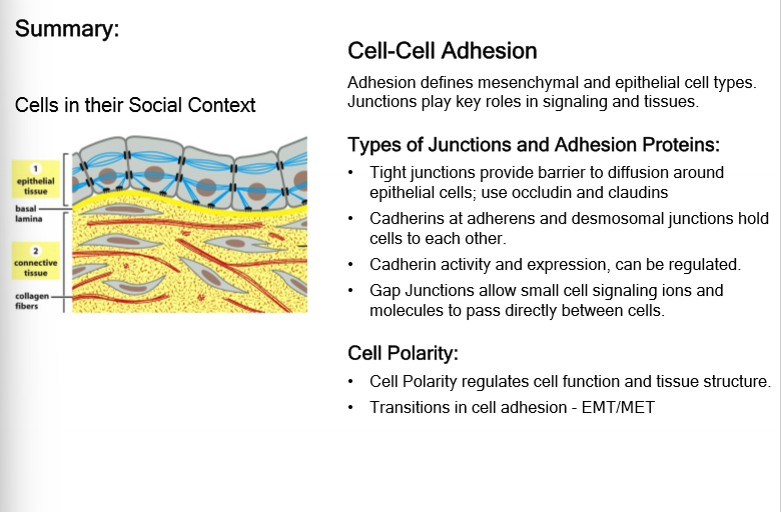Unit 4 - Cell Junctions, Adhesion, and the Extracellular Matrix
1/55
There's no tags or description
Looks like no tags are added yet.
Name | Mastery | Learn | Test | Matching | Spaced |
|---|
No study sessions yet.
56 Terms
Tissue
cellular organizational unit at a level intermediate between the cell and the complete organism; multiple cells together; ensemble of cells; EC environment associated with fluid filled spaces (lungs, kidney, or intestine); carry out a specific function; cell adhesions hold these together; ex. the skin
Boundary Tissues
epithelium/epithelia; ordered sheets of cells at boundaries like your skin, intestine, or vascular; connected by cell-cell and cell-matrix adhesions
Connective Tissues
mesenchyme, mesenchymal cells; less ordered and interior to epithelia; cartilage, adipose, and muscles; ex. cartilage, basal lamina (basement membrant), and tendon
Extracelllular Matrix
consists of the basal lamina, collagen fibers; fibrous proteins and hydrogels between cells; many forms (ordered and disordered); mechanical strength in tension and compression to hold tissues together; protein and glycoprotein networks between cells and between tissues; ex. fibronectin, laminin, collagen, elastin, hyaluronan, proteoglycan, and glycoproteins; composed of many types of molecules (proteins and polysaccacharides); forms complex networks close to cell surface; can be elastic and align when stretched
cells can transition between forms
between mesenchymal → epithelial (MET)
between epithelial → mesenchymal (EMT)
2 General Types of Tissues and Cells
epithelium/epithelial cells and mesenchyme/mesenchymal cells
Epithelium/Epithelial Cells
structured; make up barrier between organism and outside; polarized apical (cell-cell adhesions) to basal (cell-ECM adhesions)
Mesenchyme/Mesenchymal Cells
unstructured (like fibroblasts) suspended in ECM; not polarized; surface forms cell-ECM and cell-cell adhesions; ex. embryotic mesoderm, fibroblasts, mast cells, macrophages, smooth muscle cells, myocytes, adipoctyes, and chondrocytes
ECM’s Functions
assembly and modify this to expose signals or remove them; growth factor binding; can signal; this aligned can align cells; stiffness of this, alignment, and factor binding can provide guidance for migratory cells; a lot of info stored here → if cut nerve and muscle cell → if nerve grows back it will connect where it used to be (to the shell of the muscle cell) and if the muscle cell regenerates, receptors for nerve would be in the same place
Fibronectin
single chain is 2,500 aa; dimer connected via disulfide bonds at c-terminal; each chain contains multiple domains w/ diff. binding sites for ECM and cell-surface receptors; integrin receptor binds RGD and Synergy site; cell generated tension required to polyermize this can’t do it itself → opens “cryptic” sites for dimer-dimer polymerization
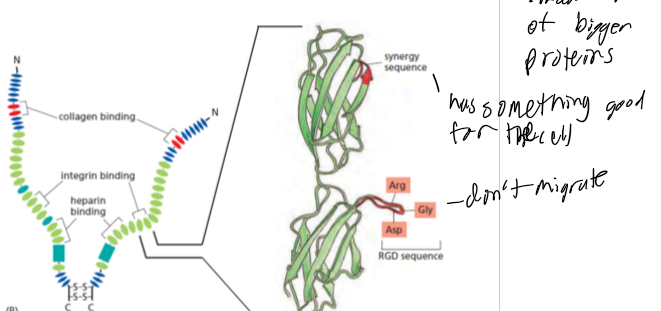
Laminin
heterotrimer; made up of alpha, beta, and gamma chain; multiple binding sites for ECM and cell-surface receptors; humans have 5 diff. alpha, 4 beta, and 3 gamma chains and 19 diff. trimeric laminins
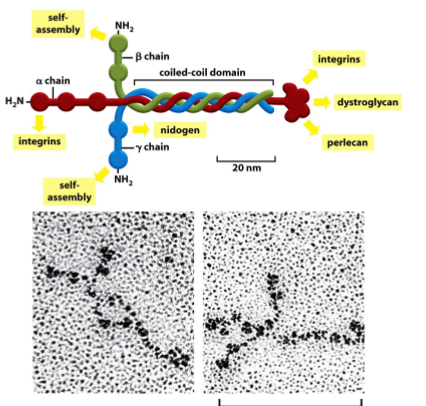
Collagen - Intracellular
transition of monomer subunit to ER; modification of prolines and lysines; triple-helix of procollagen secretion; act like steel beams for cells
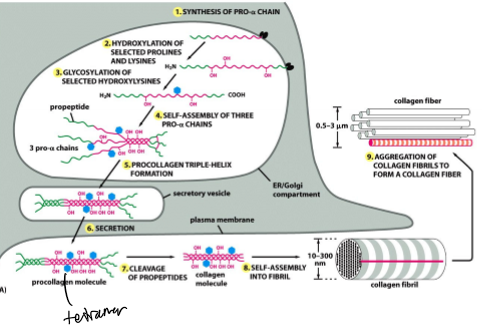
Collagen - Extracellular
crosslinking carried out by lysl-oxidase proteins (inbetween triple helixes structures - covalently attaches them together so they are more rigid and stay together better); assembly into fibrils; increased tensile strength in ECM
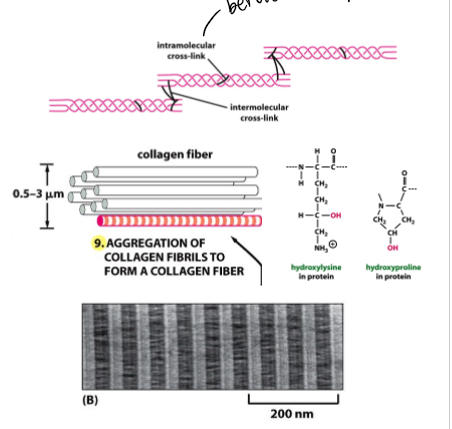
Collagen General
multiple layers in different directions like plywood; not all form fibrils
Proteoglycans and Gylcoaminoglycans
compressive element in ECM; long chain of polysaccharides covalently linked to protein cores; gigantic space filling molecules; charges on sugars draw in counter ions (Na+, K+) which draw water to pressurize tissues like tendon and cartilage
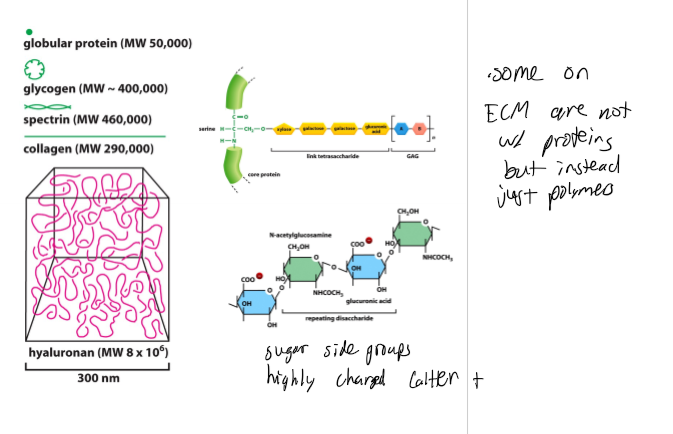
Cellular Receptors for ECM
cell surface receptors link the cytoskeleton to EC structures; integrins link ECM → cytoskeleton (hemidesmosomes and focal adhesions); rare for ECM receptors to bind directly to the cytoskeleton
inside - cytoskeleton (F-actin, IFs); adaptor or scaffolding proteins
transmembrane - receptors (cell-ECM adhesions like integrins), cell-cell adhesions (cadherins)
Hemidesmosomes
link ECM to IFs; scaffold/adaptors (dystonin and plectin)
Focal Adhesions
link ECM → F-actin; scaffold/adaptors (vinculin and talin); can be assmebled and disassembled quickly or can be stabilized (Rho family GTPases, F-actin polymerization, MAPK signaling); during - cell cycle, apoptosis, and cell motility
Integrins
heterodimers of alpha and beta subunuts; different dimers recognize specific ECM proteins and link to diff. intracellular scaffolds; a5B1 - fibronectin and a6B4 - lamin; complexes are able to change binding affinity for ECM (signals inside/outside the cell)
Signals from inside the cell - Integrins
growth factors activate integrin; gene expresion changes activity and abundance
Signals from outside the cell - Integrins
specific ligands activate integrin; tension on scaffold proteins
Summary
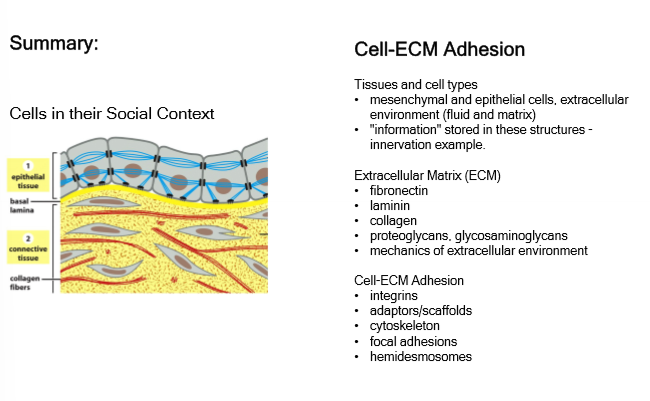
Mesenchymal vs Epithelial
mesenchymal - loosely attached with an absence of stable junctions, lack of typical apical-basal polarity, increased matrix remodeling, and expression of mesenchymal proteins
epithelial - strongly attached and form semi-permeable barrier, prescence of cell-cell junctions (tight, adherens, or desmosomes), apical-basal polarity, and expression of specific keraton IFs
Epithelia
comes in many forms; single epithelium - single layer, all cells attached to basement membrane and extend to the surface
Adhesions
both epithelial and mesenchymal have desmosomes, cell-matrix anchoring junctions, hemidesmosomes, focal adhesions, and channel forming junctions
Cell-cell Junctions
close association between neighboring cells (no fluid space between membranes); specific adhesion molecules are cell surface receptors (occludin and cadherins); nc binding in trans between 2 cells of cell surface receptors; permeability is controlled by tight junctions; strength of tissue dependent on this and cell-ECM junctions
Anchors
type of cell-cell junction; connect cytoskeleton from 1 cell to ECM or to next cell
Occluding
type of cell-cell junction; block flow of disulfide ions and molecules across epithelial sheet
Gap-Junctions
type of cell-cell junction; allow flow of inorganic salts, sugars, aa, nucleotides, and vitamins but not large molecules (proteins or nucleic acids) to move directly from cell to cell w/o receptors
Signal-relaying
type of cell-cell junction; allows discrete communication from 1 cell to the next via a shared space; secretion and cell-surface receptors or channels involved
Strength of Tissues
cell-cell and cell-ECM junctions contribute to this; connect cell cortex to intracellular cytoskeleton; depends on type and amount of cytoskeleton (F-actin or keratin IFs); increased by cell surface receptors binding in cis (same side of cell); increased in response to load
Tight Junctions
in simple epithelia; keep contents on one side of epithelium from other side; very close association of plasma membrane of 1 cell to another; can block flow of small ions/molecules; separate transmembrane proteins in apical from basolateral domains; distinctive morphology and set of transmembrane proteins
Tight Junctions - Molecular Composition
transmembrane adhesions; claudin and occludin proteins, compact molecular complexes; connects F-actin in cell cortex
Tight Junctions - Biophysical Properties
bring opp. plasma membranes to within 10 nm (really close together); strong assocations in cis; assembles closest to apical surface; regulates movement of molecules in the space between cells
Adherens Junctions - Characteristic Properties
defining feature of epithelial cells; principle “glue” that holds them into a sheet; can be dynamic; supports/transmits mech E across sheet; prevents sheet from tearing under planar stress and rupturing under pressure
Adherens Junctions - Molecular Composition
transmembrane and intracellular complex; cadherin transmembrane proteins; alpha, beta, p120-catenin adaptors (vinculin, afadin); connects neighboring cells (F-actin to adaptors to cadherin to cadherin to adaptors to F-actin)
Adherens Junctions - Biophysical Properties
reversible nc bonds; able to remodel quickly; strong associations in cis and trans; strengthens under tension; enables epithelia cells to rearrange, divide, and extrude
Cadherins
family defined by 5 extracellular IG domains (immunoglobulin) and similiar intracellular domains; directly bind beta-catenin and p120-catenin; trans interactions through 2 distal IG domains; multiple of these associate in cis, to enhance linkage to cytoskeleton and trans linkages; single pass transmembrane adhesion proteins defined by multiple extraceullar IG domains; can associate in cis through both extracellular and intracellular interactions
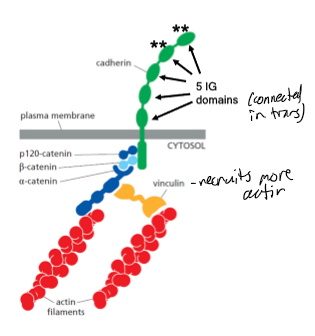
E-cadherins
defines adherens junction but also common in other cell types
Desmosomal Cadherins
differ from classical ones by intracellular domains
Desmosomal Junctions - Characteristic Properties
adhesion complex that couples keratin IFs from 1 cell to the next; considered “glue” that holds diff. types of epithelial cells into a sheet; supports/transmits mech E across epithelial sheet and to other adj. tissues; very stable but also dynamic; prevents sheets from tearing under planar stress and from rupturing under pressure
Desmosomal Junctions - Molecular Composition
cadherins (desmocolin and desmoglein); plakoglobin, desmoplakin, plakophilin adapter proteins connect intracellular cadherin domain to intracellular keratin network; couples diverse sets of keratain IFs; very stable compared to adherens junctions
Desmosomal Junctions - Biophysical Properties
stable compared to adherens junctions; function likely depends on cis and trans interactions
Homophilic Binding
cadherins of a specific type only bind to eachother in trans (E-cadherin binds to E-cadherin); contributes to cells of same type staying within a common tissue and why cells of diff. tissues do not adhere with eachother; contributes to cell sorting
Heterophilic Binding
2 different cadherins binding; integrins and selectins utilize this because it enables tisssue-tissue binding; how cells will rearrange
Gap Junctions - Characteristic Properties
adhesion complex that creates a “portal” from one cell to the next; premeability regulated by type of gap function; transmits ions like Ca++ and sugars like glucose but not proteins
Gap Junctions - Molecular Composition
6 connexin subunits in cis in the plasma membrane form a connexon (must match up in trans on 2 cells); membranes must be extremely close; allow cells to pass some molecules to each other
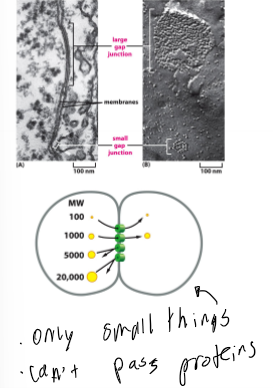
Gap Junctions - Biophysical Properties
6 connexin subunits in cis in the plasma membrane form a connexon; can form heteromeric connexons and heterotypic assemblies; pores are very small (1.5nm in diameter); couple cells electrophysiology so a response, like an AP, can travel rapidly between cells
Cell Polarity
need to maintain this to carry out specific functions; can be achieved by positioning of specific protein complexes or organelles; forward-rear, apical-basal, and planar are diff. types; determines direction of secretion and absorption, direction of migration, cell identity; can change this in response to changes in gene expression, GFs, and mechanical microenvironment
Forward-rear Polarity
important to migrating; typically in mesenchymal cells - sometimes need external signal and sometimes internal signal
Apical-basal Polarity
important to epithelia
Planar Polarity
important to epithelial organs such as the ear, intesine, skin, etc.; within the plane
Transitions in Cell adhesion
first-responders of immune system - circulating immune cells (white blood cells); rapid changes in cell-cell adhesion; invade a tissue when they are summoned by factors released by an inflammation; need to exit bloodstream and cross tight-junctional epithelium before being carried away; heterophilic adhesion; endothelium lining the blood expresses glycoproteins (ECM) on apical surface facing the blood; white blood cells (lymohocytes) express L-selectin (receptor that recognizes glycoproteins) and they also slow as selectins bind endothelial ECM; integrins on WBCs activate and bind enothelial cell surface receptor
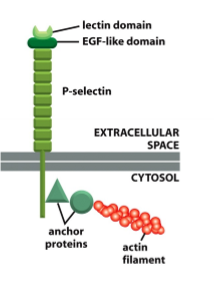
Epithelial-to-Mesenchymal Transition
e cells change gene expression and cell adhesions systems become m cells; response to signals (external) or developmental program (internal); reduce of change cell-cell adhesion and increase cell-ECM adhesion; lose tight and adherens junctions; lowered E-cadherin and apical junctions; increase motility, increase integrin activity, increase ECM assembly, and modifying programs; increase m cells gene expression (snail/twist transcrpition factos lock-in cell type
Cell-ECM Interactions
can regulate cell phenotype (polarity and behavior); EMT/MET in breast cancer cells; stiffness of ECM drives cells to go from e type to m type; modulate a cell’s ability to sense other signals (here EGF)
Summary pt. 2
